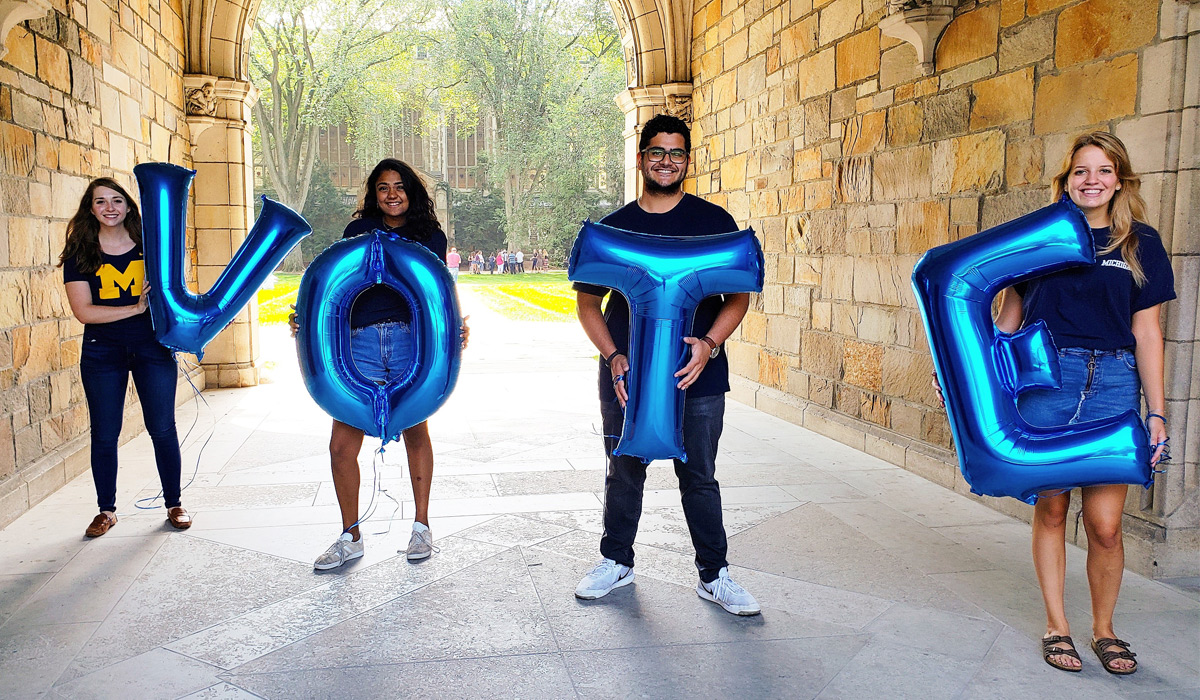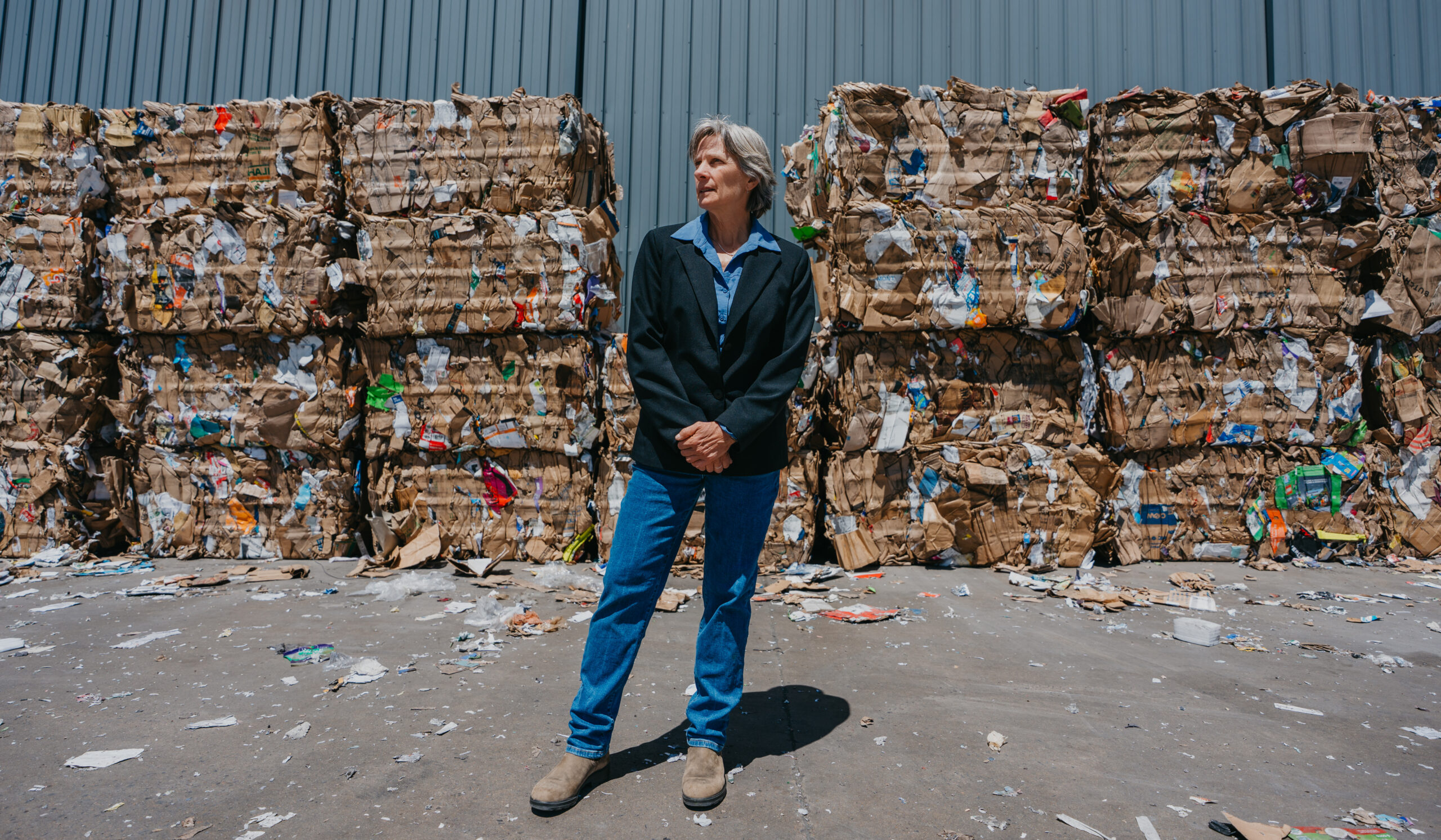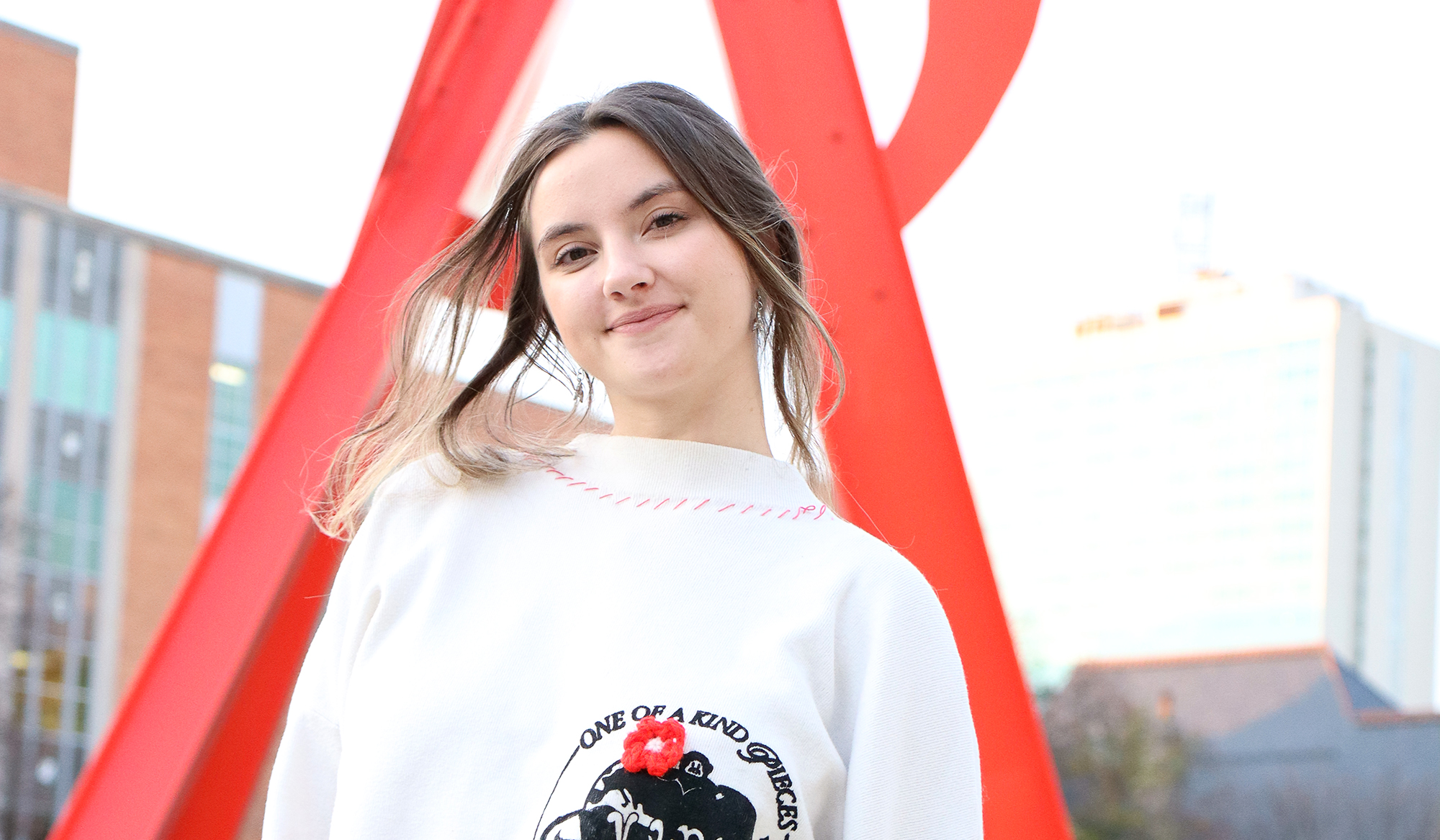Growing up, U-M senior Josiah Walker moved a lot. In all, he attended 13 different schools in small towns, suburbs, and big cities, where he befriended classmates from a wide variety of backgrounds. By the time Walker arrived at U-M in 2017, he had come to realize that, in a diverse country like the United States, everyone has a unique perspective — and that means everyone’s voice ought to be heard.
“No one party or candidate or person has all the answers to every single question,” Walker explains in an interview conducted over Zoom. “I think to deal with the challenges we face, it’s better to incorporate as many schools of thought as possible. Everybody needs to add their voice; it’s absolutely necessary.”
It was that conviction that led Walker to take up a challenge that has perplexed Americans for generations: How to get younger people, especially those between the ages of 18 and 24, to turn out and make their voices heard via the ballot box.
In 2017, U-M President Mark Schlissel announced the Big Ten Voting Challenge, a friendly competition between the 14 conference schools to see which campus could achieve the highest voter turnout in the 2018 midterm elections. U-M’s effort is managed by the Edward Ginsberg Center, which promotes civic engagement on campus, and the nonpartisan Turn Up Turnout student group. Joining the student group, Walker, along with other volunteers, spent hours staffing tables on the Diag and in dorms and dining halls.
The volunteers answered questions about voting, supplied voter registration forms, and kept plenty of pens handy. On Election Day, they organized parties at polling places on Central and North Campus, where they passed out snacks and U-M swag in an effort to make voting feel like the hot social event of the season.
“I almost didn’t vote, but I’m glad I did. I felt a sense of accomplishment, being part of my community and making that decision.”
Walker and his friends were working not only for democracy, but for Wolverine pride. And in November, they thrilled at the announcement that U-M students had tripled their turnout, with 41% of eligible voters casting a ballot, up from 14% in 2014. It was an impressive showing for a midterm election, although not enough to beat the University of Minnesota, which boosted its own turnout from less than 30% to 59%.
“I think that students are really passionate about civic engagement,” says Walker. “It’s just, sometimes they need help overcoming structural barriers and understanding how to navigate them more effectively.”
Now president of Turn Up Turnout and LSA’s student body vice president, Walker is looking forward to a Big Ten Voting Challenge rematch this year. But the COVID-19 pandemic has introduced some unanticipated difficulties, rendering their previous playbook impractical. With everything from public health and racial justice to climate change at stake, today’s young voters may feel the consequences of this election for the rest of their lives — but it may also be the strangest electoral experience the country has ever faced.
Like most of the world, U-M’s voter turnout workers have been forced to shift their strategy online. Instead of a table on the Diag, their outreach will take place over Instagram, TikTok, and Twitter. Instead of asking questions face-to-face, would-be voters will be encouraged to text a help line (833-4UM-VOTE), visit a website (govote.umich.edu), or attend virtual office hours over Zoom.
Last year, sophomore Sophie Greenberg, now Turn Up Turnout’s vice president of education, spent many hours registering new voters as they stood in line at dining halls. That’s not going to work this year, she acknowledges. But she has high hopes for the voter hotline, which will be staffed by students who are well-versed in the intricacies of registering to vote, including in other states, since some students have not returned to campus this semester. Greenberg is also working on a digital marketing campaign called “10 Tuesdays,” which will keep young voters engaged during the weeks between the start of the fall semester and Election Day.
“We have really been planning for the fall since April,” she says. “And we have a plethora of plans, a lot of different avenues of getting information to students. So I would say I’m optimistic, although obviously it’s going to be lots of trial and error and seeing what works best.”
Current events may have erected new obstacles, but 2020 has also raised the stakes — and that alone may spur young voters to the polls, whether they go in person or take advantage of new opportunities to vote from home. And while campus volunteers did much to boost U-M student voters’ enthusiasm in 2018, the numbers were also not anomalous — across the country, census data show, younger voters have nearly doubled their turnout in recent years.
“The upturn in youth voting is a fairly recent phenomenon,” says Edie Goldenberg, founder and faculty advisor of Turn Up Turnout, a former LSA dean, and a professor of political science and public policy in LSA and the Ford School of Public Policy. “They still lag — voting rates go up with age — but in 2018 they closed that gap a little bit.”
In the United States, the youth vote has long proven elusive. During the Vietnam War, young people advocated for lowering the voting age from 21 to 18, arguing that anyone who could be drafted to fight overseas also ought to have a say in government. In 1971, the 26th Amendment extended the franchise to college-age Americans, and some observers predicted that these new voters would play a decisive role in the upcoming presidential race. That year, according to Michigan Daily coverage, more than 60 percent of U-M students registered to vote. Campus activists held get-out-the-vote concerts, and students lined up by the hundreds at polling places on Election Day.
Still, U.S. census figures show just under half of voters between 18 and 24 turned out to decide between Richard Nixon and Hubert Humphrey — and that would prove a high-water mark: the youth vote dropped to 42% in the next presidential election. By the Reagan years, about one-quarter of U-M students went to the polls, while the nationwide youth vote hovered around 40%.
“Gone are the concerts, the lines and, behind it all, the intensity,” noted a Michigan Daily reporter in 1988 under the headline “More students elect not to vote.” That year, when Michael Dukakis faced George H.W. Bush, the youth vote across the country had fallen to just 36.2%, still an all-time low for a presidential race. The figures for midterms, which bring out fewer voters across the board, were even more dismal; the youth vote bottomed out in 2014 at 15.9%, about one-quarter the turnout among voters over age 65.
It’s a frustrating puzzle, says John R. Chamberlin, professor emeritus at the Ford School, who notes that surveys of young people show that the number who care deeply about contemporary causes — from climate change to Black Lives Matter — often exceeds those who turn up at the polls.
“We have more information on the people who actually vote than the people who don’t vote,” he says, “because we don’t actually have an easy way to find those who didn’t vote and get them to tell us what’s up. We don’t know who they are.”
But this low turnout, he contends, represents a loss for the country.
“Fifty years ago, when I was in graduate school at Stanford, I’d go the Stanford Mall at lunchtime and get all the customers to sign a petition to lower the voting age to 18,” he says. “It mattered then because people were dying in Vietnam. And it still matters.”
Rosario Moreno-Nava knew voting mattered, but she wasn’t sure how to get started. Early in her first year at U-M, she registered at a student government table in Angell Hall, but she used her home address in Lincoln Park, Michigan, and traveled there to cast a ballot during the 2018 midterm election. She also planned to vote in the primary this past March, but she had neglected to update her address and didn’t have time to go home.
Fortunately, Walker explained that the rules had changed, and she was now able to change her address at the polls and vote in Ann Arbor — in fact, he was happy to walk her through the process.
“I almost didn’t vote, but I’m glad I did,” she says. “I felt a sense of accomplishment, being part of my community and making that decision.”
Such seemingly simple logistical hurdles often prevent young people from voting, says Meredith Days, a senior in the Ford School who has spent much of her time on campus helping her fellow students register and get to the polls.
“I feel like it’s a misconception, by people who aren’t on a college campus, that students are not interested in voting.”
“A lot of people don’t have the information they need. Or the information is available on the internet, but it’s confusing,” she says. “Sometimes people think it’s really hard — we’ve had people come and say, ‘I don’t want to spend an hour at the DMV,’ because they equate registering with getting a driver’s license, even though it’s a form that takes maybe two minutes.”
In October 2018, the Michigan Secretary of State’s Mobile Branch Office spent a day parked outside the Michigan League. Days and fellow students helped hundreds of students to fill out and submit their voter registration forms on the last day it was possible to do so before the midterm election. It was an exhilarating, if also exhausting, experience — and one that put to rest, for Days at least, the idea that young people are apathetic.
“I feel like it’s a misconception, by people who aren’t on a college campus, that students are not interested in voting,” she says. “It’s more of an information gap. People don’t get taught about voting in high school, and they haven’t voted before, so they just don’t have the information. When we table, people are always coming up to us and saying, ‘How do I register? How do I get an absentee ballot? How do I check if I’m registered?’ We help with all of those things. That day in 2018 we were busy for probably six hours straight.”
Last year, Days became a team leader with the Andrew Goodman Foundation, a New Jersey-based nonprofit started in 1966 by the parents of a 20-year-old civil rights activist killed by the Ku Klux Klan as he worked to register Black voters in Mississippi. With support from the foundation, Days has been spreading the word about Michigan’s Proposition 3, or Promote the Vote, a ballot measure passed in 2018 that provides for same-day registration and no-excuse absentee voting, which may make it easier for students to vote.
Ginsburg Center staffer Erin Byrnes, ’07, leads Michigan’s efforts in the Big Ten Voting Challenge. Also a city council member in Dearborn, Michigan, she has been gratified to watch students become engaged in the democratic process. But she knows that this election will be very different.
“We’re sending home the message that at the University of Michigan, if you are eligible to vote, we want you to vote,” Byrnes says. “We want you to be informed, and we will support you in that process.”
Byrnes and the student volunteers she works with have found that the social aspect of voting is crucial — among the most effective tactics in raising 2018 turnout were tabling at busy campus locations and holding parties at polling places.
“In-person, peer-to-peer voter registration has been our bread and butter,” Byrnes says. “But of course, that was all pre-COVID.”
Still, Byrnes and the whole U-M Big Ten Challenge Team are determined to overcome these pandemic-era complications; they believe too much is at stake to allow students to sit out this or any election.
“We really don’t care how people vote, we just want them to vote,” says Goldenberg. “We are careful to be nonpartisan, to welcome all.”
While she acknowledges that young people are generally assumed to lean toward Democratic candidates and progressive causes, she argues that increasing youth turnout is something that Americans of every political stripe ought to cheer.
“A democracy is healthy when people are being heard,” she says. “And that doesn’t mean just some small minority of the people; that means all of them. Students have passionate views, they care about things, and we think that students should have a voice. We want them to grow into being responsible citizens in our democracy, and part of that is voting.”
Amy Crawford is a writer living in Ann Arbor. Her stories have also appeared in Smithsonian, HuffPost, and Nature Conservancy magazine.





